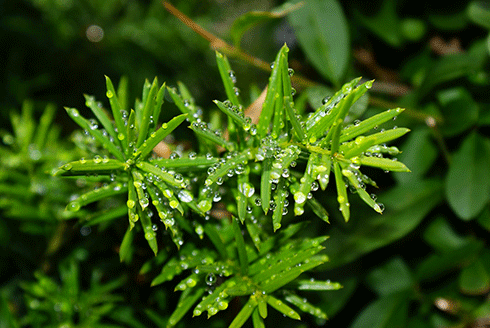
|
Published: 26 May 2014
New research shows plants and rain may have a deeper connection
Current climate models may underestimate the full impact of forest vegetation on rainfall, meaning the potential consequences of land-cover change on global temperature increase can’t be assessed with certainty, according to new research.

|
|
Life depends on rain but rain might also depend on life. Credit:
David Win CC BY-NC-ND 2.0
|
In a recent paper published in Trends in Plant Science, ecologist Douglas Sheil, from the Norwegian University of Life Sciences and associate researcher with the Center for International Forestry Research (CIFOR), concludes that erratic rainfall could worsen with deforestation.
Forest cover change could also be behind a perceived eastward shift of the rainfall zone over Southeast Asia, with a potential regional and global impact that may have been demonstrated by the ferocity of fires in Sumatra, Indonesia, in 2013 that caused a thick haze, Sheil said.
‘Vegetation probably has an even bigger effect on climate than we’ve realised,’ he added.
Standard models used to forecast climate change take into account the physical properties of forests — the way they reflect sunlight or the friction created as wind blows over them — but overlook biological processes that could affect air flow and cloud formation significant for rain production.
A recent study, cited in Sheil’s paper, showed that winds travelling through forests typically produce more than twice as much rain as those that blow over open land, leading to predictions from scientists that by 2050, the tropics could see a 12 per cent and 21 per cent decline in wet and dry season precipitation, respectively.
Transpiration ‘is an active biological process’ that is not fully reflected in the physics of climate models, Sheil said.
Transpiration from vegetation may contribute as much as 90 per cent of the moisture in the atmosphere derived from land surfaces — far more than earlier estimates.
Trees produce flows of water vapour that are typically more than 10 times greater than from herbaceous vegetation per unit of land area, surpassing those produced by wet ground or open water.
Sheil concluded that, while increasing atmospheric CO2 could lead to larger, denser forests that store more carbon, it could also reduce the amount of atmospheric moisture they produce through their leaves — and, therefore, the amount of rainfall over the forest and downwind.
In the past, researchers have posited the idea of forests acting as a ‘biotic pump,’ that draw in moist air as it rises over forested regions, which then condenses and creates a low-pressure area that draws in more moist air, creating a positive feedback loop.
Deforestation breaks the cycle, disrupting precipitation and making it more variable, not only by reducing transpiration and cloud formation, but also by slowing or disrupting the flow of air inland from coastal areas.
That means less moisture arrives from outside the region to fall as rain, resulting in further drying of the forest, and less transpiration and precipitation. This sets up a negative feedback loop that could — in an extreme scenario — change a moist forest region into a dry environment, according to Sheil.
Trees also influence cloud formation by emitting carbon-based chemicals called volatile organic compounds (VOCs) into the atmosphere.
Some of those compounds are deposited on tiny airborne particles such as dust, bacteria, pollen and fungal spores. As the particles grow with the deposition of VOCs, they promote condensation and gather the resulting moisture, hastening cloud formation.
‘It’s amazingly complex, and in a sense we’re still kind of in the dark ages. There is a link, but we don’t really understand it,’ Sheil said.
Source: CIFOR



